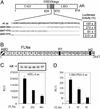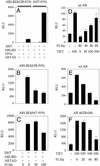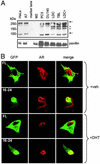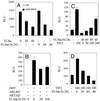Filamin-A fragment localizes to the nucleus to regulate androgen receptor and coactivator functions
- PMID: 12682292
- PMCID: PMC153595
- DOI: 10.1073/pnas.0736237100
Filamin-A fragment localizes to the nucleus to regulate androgen receptor and coactivator functions
Abstract
The androgen receptor (AR), a nuclear transcription factor, mediates male sexual differentiation, and its excessive action is associated with prostate cancer. We have characterized a negative regulatory domain in the AR hinge region, which interacted with filamin A (FLNa), an actin-binding cytoskeletal protein. FLNa interfered with AR interdomain interactions and competed with the coactivator transcriptional intermediary factor 2 to specifically down-regulate AR function. Although full-length FLNa was predominantly cytoplasmic, a C-terminal 100-kDa fragment of FLNa colocalized with AR to the nucleus. This naturally occurring FLNa fragment repressed AR transactivation and disrupted AR interdomain interactions and transcriptional intermediary factor 2-activated AR function in a manner reminiscent of full-length FLNa, raising the possibility that the inhibitory effects of cytoplasmic FLNa may be transduced through this fragment, which can localize to the nucleus and form part of the pre-initiation complex. This unanticipated role of FLNa adds to the growing evidence for the involvement of cytoskeletal proteins in transcription regulation.
Figures





Similar articles
-
Interaction of filamin A with the insulin receptor alters insulin-dependent activation of the mitogen-activated protein kinase pathway.J Biol Chem. 2003 Jul 18;278(29):27096-104. doi: 10.1074/jbc.M301003200. Epub 2003 May 6. J Biol Chem. 2003. PMID: 12734206
-
A 90 kDa fragment of filamin A promotes Casodex-induced growth inhibition in Casodex-resistant androgen receptor positive C4-2 prostate cancer cells.Oncogene. 2007 Sep 6;26(41):6061-70. doi: 10.1038/sj.onc.1210435. Epub 2007 Apr 9. Oncogene. 2007. PMID: 17420725
-
Nuclear versus cytoplasmic localization of filamin A in prostate cancer: immunohistochemical correlation with metastases.Clin Cancer Res. 2009 Feb 1;15(3):788-96. doi: 10.1158/1078-0432.CCR-08-1402. Clin Cancer Res. 2009. PMID: 19188148 Free PMC article.
-
New insights into the versatile roles of platelet FlnA.Platelets. 2013;24(1):1-5. doi: 10.3109/09537104.2011.654004. Epub 2012 Feb 28. Platelets. 2013. PMID: 22372530 Free PMC article. Review.
-
Identification and characterization of androgen receptor associated coregulators in prostate cancer cells.J Biol Regul Homeost Agents. 2001 Apr-Jun;15(2):123-9. J Biol Regul Homeost Agents. 2001. PMID: 11501969 Review.
Cited by
-
CR6-interacting factor 1 represses the transactivation of androgen receptor by direct interaction.Mol Endocrinol. 2008 Jan;22(1):33-46. doi: 10.1210/me.2007-0194. Epub 2007 Sep 20. Mol Endocrinol. 2008. PMID: 17885209 Free PMC article.
-
Whole-Exome Sequencing Identified Rare Genetic Variants Associated with Undervirilized Genitalia in Taiwanese Pediatric Patients.Biomedicines. 2023 Jan 17;11(2):242. doi: 10.3390/biomedicines11020242. Biomedicines. 2023. PMID: 36830778 Free PMC article.
-
The dual role of filamin A in cancer: can't live with (too much of) it, can't live without it.Endocr Relat Cancer. 2013 Nov 4;20(6):R341-56. doi: 10.1530/ERC-13-0364. Print 2013 Dec. Endocr Relat Cancer. 2013. PMID: 24108109 Free PMC article. Review.
-
Repression of androgen receptor activity by HEYL, a third member of the Hairy/Enhancer-of-split-related family of Notch effectors.J Biol Chem. 2011 May 20;286(20):17796-808. doi: 10.1074/jbc.M110.198655. Epub 2011 Mar 17. J Biol Chem. 2011. PMID: 21454491 Free PMC article.
-
Mutations in the N-terminal actin-binding domain of filamin C cause a distal myopathy.Am J Hum Genet. 2011 Jun 10;88(6):729-740. doi: 10.1016/j.ajhg.2011.04.021. Epub 2011 May 27. Am J Hum Genet. 2011. PMID: 21620354 Free PMC article.
References
-
- Wurtz J M, Bourguet W, Renaud J P, Vivat V, Chambon P, Moras D, Gronemeyer H. Nat Struct Biol. 1996;3:87–94. - PubMed
-
- Berrevoets C A, Doesburg P, Steketee K, Trapman J, Brinkmann A O. Mol Endocrinol. 1998;12:1172–1183. - PubMed
-
- He B, Kemppainen J A, Wilson E M. J Biol Chem. 2000;275:22986–22994. - PubMed
-
- Lim J, Ghadessy F J, Abdullah A A, Pinsky L, Trifiro M, Yong E L. Mol Endocrinol. 2000;14:1187–1197. - PubMed
Publication types
MeSH terms
Substances
LinkOut - more resources
Full Text Sources
Other Literature Sources
Research Materials
Miscellaneous

